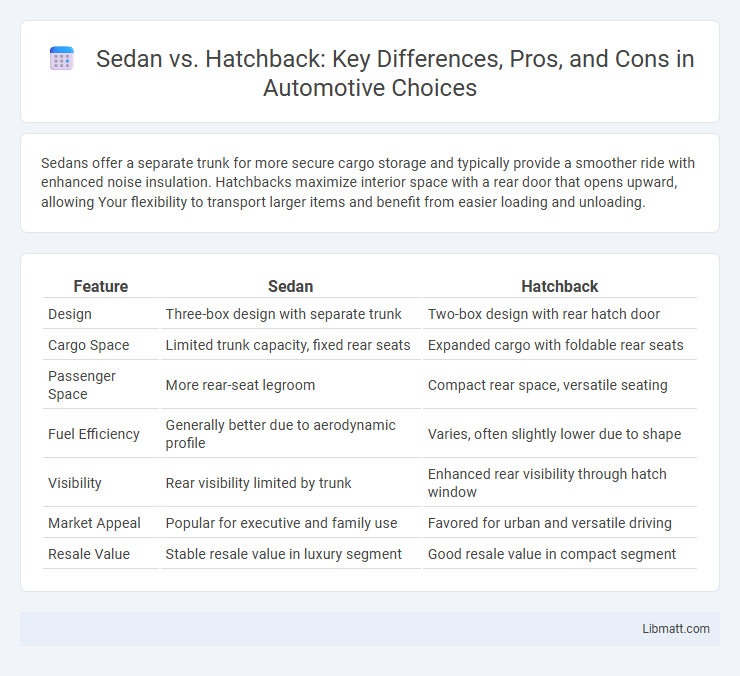Sedans offer a separate trunk for more secure cargo storage and typically provide a smoother ride with enhanced noise insulation. Hatchbacks maximize interior space with a rear door that opens upward, allowing Your flexibility to transport larger items and benefit from easier loading and unloading.
Table of Comparison
| Feature | Sedan | Hatchback |
|---|---|---|
| Design | Three-box design with separate trunk | Two-box design with rear hatch door |
| Cargo Space | Limited trunk capacity, fixed rear seats | Expanded cargo with foldable rear seats |
| Passenger Space | More rear-seat legroom | Compact rear space, versatile seating |
| Fuel Efficiency | Generally better due to aerodynamic profile | Varies, often slightly lower due to shape |
| Visibility | Rear visibility limited by trunk | Enhanced rear visibility through hatch window |
| Market Appeal | Popular for executive and family use | Favored for urban and versatile driving |
| Resale Value | Stable resale value in luxury segment | Good resale value in compact segment |
Introduction to Sedans and Hatchbacks
Sedans typically feature a separate trunk compartment offering ample storage space, while hatchbacks integrate the cargo area with the passenger cabin for versatile load capacity. You'll find sedans often preferred for their classic design and quieter ride, whereas hatchbacks provide easier access to the rear and enhanced practicality. Understanding these core structural differences helps determine which vehicle type suits your lifestyle and space needs best.
Key Differences Between Sedan and Hatchback
Sedans feature a distinct trunk separated from the passenger area, offering more secure and organized cargo storage, while hatchbacks have a rear door that includes the back window, providing easier access to a larger, versatile cargo space. Sedans typically deliver a smoother ride and better aerodynamics due to their elongated design, whereas hatchbacks excel in maneuverability and urban parking thanks to their compact shape. Your choice depends on preferences for cargo flexibility versus traditional styling and ride comfort.
Design and Aesthetics Comparison
Sedans typically feature a three-box design with a distinct trunk, offering a classic and elegant appearance that appeals to those valuing a formal aesthetic. Hatchbacks boast a two-box design with a rear door that swings upwards, providing a sportier and more practical look, favored for urban agility and ease of access. Your choice between sedan and hatchback will influence the vehicle's silhouette, with sedans emphasizing refined proportions and hatchbacks highlighting functionality and compactness.
Cargo Space and Practicality
Hatchbacks typically offer greater cargo space and flexibility due to their rear door and foldable rear seats, making them ideal for transporting larger items and optimizing storage capacity. Sedans, while providing a separate trunk, often have less versatile cargo arrangements and limited vertical storage height. Practicality in hatchbacks is enhanced by easier access to the entire cargo area, benefiting urban drivers and those with active lifestyles.
Performance and Handling
Sedans typically offer a more balanced weight distribution and lower center of gravity, enhancing stability and smooth handling at higher speeds. Hatchbacks often feature a shorter wheelbase and lighter weight, resulting in quicker acceleration and more agile maneuverability in urban environments. Performance differences also stem from engine options and tuning, with sedans frequently prioritizing comfort and long-distance driving, while hatchbacks lean toward sporty responsiveness and versatility.
Fuel Efficiency and Economy
Sedans generally offer better fuel efficiency due to their aerodynamic design and lighter weight compared to hatchbacks, making them ideal for long-distance driving and highway fuel savings. Hatchbacks, while slightly less fuel-efficient, provide greater cargo flexibility and often come with smaller engine options that can enhance urban fuel economy. Your choice between the two should consider daily driving patterns and the balance between fuel economy and practicality.
Comfort and Interior Features
Sedans typically offer more spacious rear legroom and a quieter cabin, enhancing overall comfort on long drives. Hatchbacks prioritize versatility with foldable rear seats and easy access to the cargo area, providing practical interior features for active lifestyles. You can choose based on whether you value a refined, roomy interior or flexible storage options for daily use.
Safety and Security Features
Sedans typically offer enhanced structural integrity and advanced safety features such as multiple airbags, ABS, and stability control, providing a secure driving experience. Hatchbacks often incorporate rear visibility aids, collision warning systems, and reinforced frames, making them equally safe despite their compact design. Your choice should consider specific model safety ratings and desired security technologies to ensure optimal protection on the road.
Cost of Ownership
Sedans typically have a lower initial purchase price but may incur higher maintenance costs due to more complex body structures compared to hatchbacks. Hatchbacks often offer better fuel efficiency and cheaper insurance premiums, reducing your overall cost of ownership. Choosing a hatchback can result in long-term savings thanks to its practicality and lower depreciation rates.
Which Should You Choose: Sedan or Hatchback?
Sedans offer a spacious trunk and a sleek design ideal for formal settings, while hatchbacks provide versatile cargo space with rear seats that fold down, enhancing practicality for urban lifestyles. Choosing between a sedan and hatchback depends on your priority for passenger comfort versus cargo flexibility and the typical driving environment. Sedans generally excel in fuel efficiency and ride comfort, whereas hatchbacks cater to those needing adaptable storage and easier maneuverability in tight spaces.
sedan vs hatchback Infographic

 libmatt.com
libmatt.com